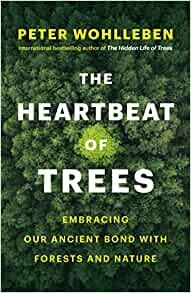Optimism
The Heartbeat of Trees: An Uplifting Spring Read
Peter Wohlleben shows that bonding with trees can foster optimism and hope.
Posted April 3, 2021 Reviewed by Gary Drevitch
Key points
- As we're able to do more outside, taking a walk and stopping to touch and possibly talk to trees is good for them and for us.
- There's a lot to consider in Peter Wohlleben's new book about our ancient bond with forests and nature.
- Tress and roots, research suggests, may actually be sensitive to our touch, but the benefits to us of touching them are well proven.

Years ago when I lived in the mountains outside of Boulder, I used to run into a guy who called himself Elf who talked to and touched the trees on my hiking and running route. I once asked him why he was doing it and he simply said it made him feel better—more connected to nature—and he was sure the trees "liked it" too.
My conversations with Elf got me to say "hello" to the trees and flowers around my home, including flowers I had in my living room. While I don't know if my gleeful greetings did anything positive for them, I'm sure it didn't hurt them. And acknowledging their presence made me feel more connected to them and made me continue to wonder what's happening inside of these amazing beings.
Today, there is a good deal of solid scientific evidence that trees (and likely other flora) are sensitive to all sorts of environmental stimuli including those offered by humans, and Elf, whether he knew it or not—or now knows about the science—was right on the mark. I would like to inform readers about a new and fascinating book about which I hope Elf knows if he's still around.

We're living in difficult and trying times, so I was pleased to read about how a simple walk in the woods and an appreciation of the secret lives of trees can lead to more optimism and hope for a better future for us and for them. Nature writer Peter Wolhlleben's The Heartbeat of Trees: Embracing Our Ancient Bond with Forests and Nature1 is a detailed, easy-to-read summary of what research has shown us about "the language of the forest, the consciousness of plants, and the eroding boundary between flora and fauna." In this excellent and updated sequel to his The Hidden Life of Trees, in which he wrote about the possibility that trees feel pain, Wohlleben writes beautifully about the reciprocal bonds we can form with trees and all sorts of nature.
The Heartbeat of Trees builds on a large and growing database showing that being out in nature makes many people feel good. Along these lines, he writes that if one hugs a tree it would be wrong to expect the tree to return the favor, but trees are sensitive to touch. So too are roots. Concerning heartbeats, he notes that of course trees don't have heartbeats like ours, and that water that is transported into the crown of trees is their blood. And pea roots can hear water flowing underground.
After offering a wonderful journey into the heartbeat and hidden lives of of trees, Wohlleben writes, "What we need right now is hope, not despair." It's the changes in our hearts, rather than our minds, that sow the seeds of hope.
When I finished The Heartbeat of Trees and reflected on my encounters with the prescient Elf, I also remembered my work with a troubled teenage girl, Mira, who drew lovely pictures of trees because "they made her feel good and good about herself." I also hope that wherever she is now she knows about Wohlleben's work. There also is some very useful information for conservation psychologists who "study of the reciprocal relationships between humans and the rest of nature, with the goal of encouraging conservation of the natural world."
I keep my copy of The Heartbeat of Trees in a place where I can grab it and reread different sections. For people who want to read about facts of nature that likely will be new for them, this should be a go-to book.
So, as we're able to do more outside with others, get up and go out and take a walk and stop to talk to and touch the trees along your route. It's easy and cheap. (Find out more from Project Learning Tree.)
My friend Margot, who lives in a big city, told me that interacting with trees—touching and talking to them amid the incessant noise and turmoil in her neighborhood—"has really helped lift my spirits in dark times." When I wrote to Margot about Elf, Mira, and my own decision to greet trees and flowers, she told me she would read The Heartbeat of Trees and tell her friends and family about it because some thought she was "off and had lost my mind."
Margot wasn't "off" and didn't lose her mind. Rather, her active and open mind got her to think about the importance of understanding the inner lives of trees and plants and as a result, she opened her heart to them. We also know that merely visiting plants can alter herbivory, including seed production and competition — also known as the Herbivory Uncertainty Principle.
As Wohlleben demonstrates, getting in touch with trees and their heartbeats can help us get in touch with ourselves. There surely is nothing to lose and if something is gained, it's a win-win for all at a time when we really need uplifting positive experiences.
References
Notes
1) The description for The heartbeat of Trees reads: A powerful return to the forest, where trees have heartbeats and roots are like brains that extend underground. Where the color green calms us, and the forest sharpens our senses. In The Heartbeat of Trees, renowned forester Peter Wohlleben draws on new scientific discoveries to show how humans are deeply connected to the natural world. In an era of climate change, many of us fear we’ve lost our connection to nature—but Peter Wohlleben is convinced that age-old ties linking humans to the forest remain alive and intact. We just have to know where to look. Drawing on science and cutting-edge research, The Heartbeat of Trees reveals the profound interactions humans can have with nature, exploring: the language of the forest, the consciousness of plants, and the eroding boundary between flora and fauna. A perfect book to take with you into the woods, The Heartbeat of Trees shares how to see, feel, smell, hear, and even taste the forest. Peter Wohlleben, renowned for his ability to write about trees in an engaging and moving way, reveals a wondrous cosmos where humans are a part of nature, and where conservation and environmental activism is not just about saving trees—it’s about saving ourselves, too.
Bekoff, Marc. The Inner Life of Animals: Love, Grief, and Compassion. (An Interview with Peter Wohlleben, author of a recent book on animal emotions.)
Gagliano, Monica. Thus Spoke the Plant: A Remarkable Journey of Groundbreaking Scientific Discoveries and Personal Encounters with Plants. ReadHowYouWant, 2020.
Project Learning Tree. FAMILY ACTIVITY: GET IN TOUCH WITH TREES.




